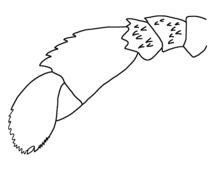Eurypterina
| Eurypterina | |
|---|---|

| |
| The defining characteristic of eurypterine eurypterids is the transformation of the sixth pair of legs into swimming paddles. Reconstructed leg of Bassipterus. | |
| Scientific classification | |
| Domain: | Eukaryota |
| Kingdom: | Animalia |
| Phylum: | Arthropoda |
| Subphylum: | Chelicerata |
| Clade: | Sclerophorata
|
| Order: | †Eurypterida |
| Suborder: | †Eurypterina Burmeister, 1843 |
| Type species | |
| † Eurypterus remipes De Kay, 1825
| |
| Subgroups | |
Incertae sedis | |
| Synonyms | |
| |
Eurypterina is one of two
Seventy-five percent of
Though more numerous both in specimens and taxa, the eurypterines have the shorter temporal range of the two eurypterid suborders. They first appeared around the same time as the
Description
The Stylonurina and Eurypterina are most easily distinguished by the morphology of the posteriormost prosomal appendage. In the Stylonurina, this appendage takes the form of a long and slender walking leg, lacking a modified spine (termed podomere 7a). In the Eurypterina, the leg is most usually modified and broadened into a swimming paddle and always includes a podomere 7a.[3]
Swimming eurypterines represent the absolute majority of both known eurypterid species and known specimens, though the morphology of the walking stylonurines is almost as diverse in appearance, and the fossil record of the eurypterines may therefore simply be more complete than that of the stylonurines, possibly due to varying habitat preferences.[3]
Paleobiogeography

The most basal eurypterines with swimming legs, the genus Onychopterella, are known from the east coast of Gondwana close to the equator (a region that today is South Africa) from the Late Ordovician. It is not known whether or not the swimming forms originated here or not, but it is speculated that they migrated from Laurentia, since most stylonurines and basal swimming forms are predominantly known from Laurentia and Gondwana otherwise completely lacks basal swimming forms.[3]
The
The majority of
Although the
Systematics and relationships

Eurypterina contains eight superfamilies -
In contrast to the Megalograptoidea, the Eurypteroidea is a rather well-known clade that contains around 90% of all known eurypterid specimens. They were closely related, supported by numerous similarities, to the Carcinosomatoidea. The Carcinosomatoidea have a poorly resolved internal phylogeny, though can be easily recognised by scorpion-like appearance and heavily spinose appendages.[3]

Suborder Eurypterina Burmeister, 1843
- Superfamily OnychopterelloideaLamsdell, 2011
- Family Onychopterellidae Lamsdell, 2011
- Superfamily MoselopteroideaLamsdell, Braddy, & Tetlie, 2010
- Family Moselopteridae Lamsdell, Braddy, & Tetlie, 2010
- Superfamily Eurypteroidea Burmeister, 1843
- Family Dolichopteridae Kjellesvig-Waering & Størmer, 1952
- Family Eurypteridae Burmeister, 1843
- Family Strobilopteridae Lamsdell & Selden, 2013
- Superfamily Carcinosomatoidea Størmer, 1934
- Family Carcinosomatidae Størmer, 1934
- Family Megalograptidae Caster & Kjellesvig-Waering, 1955
- Family Mixopteridae Caster & Kjellesvig-Waering, 1955
- Superfamily Waeringopteroidea(not formally published)
- Family Waeringopteridae (not formally published)
- Superfamily AdelophthalmoideaTollerton, 1989
- Family Adelophthalmidae Tollerton, 1989
- Superfamily Pterygotioidea Clarke & Ruedemann, 1912
- Family Hughmilleriidae Kjellesvig-Waering, 1951
- Family Slimonidae Novojilov, 1962
- Family Ptergotidae Clarke & Ruedemann, 1912
Phylogeny
Eurypterines are characterised by the transformation of the posteriormost prosomal appendage into a swimming paddle, one of the main features used to distinguish them from the stylonurines. The cladogram presented below, simplified from a study by Tetlie,[3] showcases the phylogenetic relationships of the Eurypterina based on this adaptation, and the enlargement of the chelicerae, which characterises the family Pterygotidae, to be used for active prey capture.
| Eurypterida |
| ||||||||||||||||||||||||||||||||||||
See also
- Mixopterus
- Eurypterus
- Pterygotus
- Eurypterid
- Stylonurina
- List of eurypterids
References
- S2CID 88413267.
- S2CID 42371883.
- ^ doi:10.1016/j.palaeo.2007.05.011. Archived from the original(PDF) on 2011-07-18.
- .
- S2CID 85398946.
